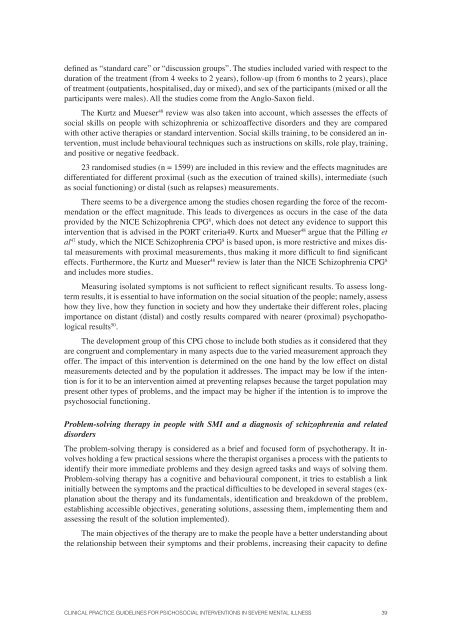CPG for Psychosocial Interventions in Severe Mental ... - GuÃaSalud
CPG for Psychosocial Interventions in Severe Mental ... - GuÃaSalud
CPG for Psychosocial Interventions in Severe Mental ... - GuÃaSalud
Create successful ePaper yourself
Turn your PDF publications into a flip-book with our unique Google optimized e-Paper software.
def<strong>in</strong>ed as “standard care” or “discussion groups”. The studies <strong>in</strong>cluded varied with respect to the<br />
duration of the treatment (from 4 weeks to 2 years), follow-up (from 6 months to 2 years), place<br />
of treatment (outpatients, hospitalised, day or mixed), and sex of the participants (mixed or all the<br />
participants were males). All the studies come from the Anglo-Saxon field.<br />
The Kurtz and Mueser 48 review was also taken <strong>in</strong>to account, which assesses the effects of<br />
social skills on people with schizophrenia or schizoaffective disorders and they are compared<br />
with other active therapies or standard <strong>in</strong>tervention. Social skills tra<strong>in</strong><strong>in</strong>g, to be considered an <strong>in</strong>tervention,<br />
must <strong>in</strong>clude behavioural techniques such as <strong>in</strong>structions on skills, role play, tra<strong>in</strong><strong>in</strong>g,<br />
and positive or negative feedback.<br />
23 randomised studies (n = 1599) are <strong>in</strong>cluded <strong>in</strong> this review and the effects magnitudes are<br />
differentiated <strong>for</strong> different proximal (such as the execution of tra<strong>in</strong>ed skills), <strong>in</strong>termediate (such<br />
as social function<strong>in</strong>g) or distal (such as relapses) measurements.<br />
There seems to be a divergence among the studies chosen regard<strong>in</strong>g the <strong>for</strong>ce of the recommendation<br />
or the effect magnitude. This leads to divergences as occurs <strong>in</strong> the case of the data<br />
provided by the NICE Schizophrenia <strong>CPG</strong> 8 , which does not detect any evidence to support this<br />
<strong>in</strong>tervention that is advised <strong>in</strong> the PORT criteria49. Kurtx and Mueser 48 argue that the Pill<strong>in</strong>g et<br />
al 47 study, which the NICE Schizophrenia <strong>CPG</strong> 8 is based upon, is more restrictive and mixes distal<br />
measurements with proximal measurements, thus mak<strong>in</strong>g it more difficult to f<strong>in</strong>d significant<br />
effects. Furthermore, the Kurtz and Mueser 48 review is later than the NICE Schizophrenia <strong>CPG</strong> 8<br />
and <strong>in</strong>cludes more studies.<br />
Measur<strong>in</strong>g isolated symptoms is not sufficient to reflect significant results. To assess longterm<br />
results, it is essential to have <strong>in</strong><strong>for</strong>mation on the social situation of the people; namely, assess<br />
how they live, how they function <strong>in</strong> society and how they undertake their different roles, plac<strong>in</strong>g<br />
importance on distant (distal) and costly results compared with nearer (proximal) psychopathological<br />
results 50 .<br />
The development group of this <strong>CPG</strong> chose to <strong>in</strong>clude both studies as it considered that they<br />
are congruent and complementary <strong>in</strong> many aspects due to the varied measurement approach they<br />
offer. The impact of this <strong>in</strong>tervention is determ<strong>in</strong>ed on the one hand by the low effect on distal<br />
measurements detected and by the population it addresses. The impact may be low if the <strong>in</strong>tention<br />
is <strong>for</strong> it to be an <strong>in</strong>tervention aimed at prevent<strong>in</strong>g relapses because the target population may<br />
present other types of problems, and the impact may be higher if the <strong>in</strong>tention is to improve the<br />
psychosocial function<strong>in</strong>g.<br />
Problem-solv<strong>in</strong>g therapy <strong>in</strong> people with SMI and a diagnosis of schizophrenia and related<br />
disorders<br />
The problem-solv<strong>in</strong>g therapy is considered as a brief and focused <strong>for</strong>m of psychotherapy. It <strong>in</strong>volves<br />
hold<strong>in</strong>g a few practical sessions where the therapist organises a process with the patients to<br />
identify their more immediate problems and they design agreed tasks and ways of solv<strong>in</strong>g them.<br />
Problem-solv<strong>in</strong>g therapy has a cognitive and behavioural component, it tries to establish a l<strong>in</strong>k<br />
<strong>in</strong>itially between the symptoms and the practical difficulties to be developed <strong>in</strong> several stages (explanation<br />
about the therapy and its fundamentals, identification and breakdown of the problem,<br />
establish<strong>in</strong>g accessible objectives, generat<strong>in</strong>g solutions, assess<strong>in</strong>g them, implement<strong>in</strong>g them and<br />
assess<strong>in</strong>g the result of the solution implemented).<br />
The ma<strong>in</strong> objectives of the therapy are to make the people have a better understand<strong>in</strong>g about<br />
the relationship between their symptoms and their problems, <strong>in</strong>creas<strong>in</strong>g their capacity to def<strong>in</strong>e<br />
CLINICAL PRACTICE GUIDELINES FOR PSICHOSOCIAL INTERVENTIONS IN SEVERE MENTAL ILLNESS 39

















